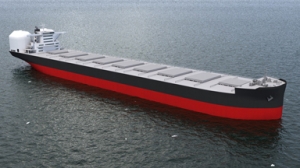


(Posted on 31/01/19)
Leading Classification Society ClassNK has granted an Approval in Principle (AIP) based on its Rule Part GF which adopts IGF Code (regulation for ships using low-flashpoint fuels) to Kawasaki Heavy Industries (KHI) for their project on the concept design of an LNG-fuelled 207K DWT bulk carrier.
Speaking on the occasion, ClassNK Corporate Officer and Director of Technical Solution Department Hayato Suga said “The maritime industry has been setting its sights on LNG as an energy source for ships as it is an environmentally-friendly alternative to fossil fuels. Kawasaki Heavy Industries is taking full advantage of this opportunity as well with their new bulk carrier design. We have carefully confirmed the safety of the design and are proud to contribute to this project.”
With the International Maritime Organization (IMO) imposing tighter restrictions on emissions of greenhouse gases and air pollutants, the shipping industry has been increasing its focus on utilizing LNG and other “clean” fuels in place of conventional fuel oil. Against this backdrop, and utilizing technological prowess attained through building LNG carriers for many years, Kawasaki has been developing various LNG-related vessels, such as the world’s first LNG-fueled car carrier, delivered in 2016, and LNG bunkering vessels, which has culminated in an ample pool of LNG-related application technology. Combined with additional technological innovations and knowledge developed in the course of acquiring the AiP for this bulk carrier, which complies with the latest international regulations, Kawasaki is fully equipped to proceed with its design and building, as well as to apply these technologies to other types of ships.
Moving forward, Kawasaki plans to widen its application of LNG propulsion technology in commercial vessels, and to increase its focus on building LNG-fueled vessels, for which demand is expected to grow globally in the future.
Principal features of the new LNG-fueled carrier
1)By configuring the LNG fuel tank behind the accommodation in the stern, the ship keeps its cargo space as large as that of conventional oil-fueled ships.
2)Powered by low-speed, dual-fuel diesel engine, the ship achieves significantly reduced emissions of carbon dioxide (CO2), nitrogen oxides (NOx), sulfur oxides (SOx), and particulate matter (PM) when using LNG as fuel, meeting the EEDI**Phase 3 requirements.
Torvald Klaveness has announced the decision to consolidate all digital services under Klaveness Digital... Read more
The International Association of Dry Cargo Shipowners (INTERCARGO) has renewed its call for straightforward... Read more
The Swedish Club has delivered strong results for 2024, posting a USD 34 million profit and significantly... Read more
In line with NORDEN’s positive long-term outlook for Capesize freight rates, the company have... Read more
OrbitMI, a global provider of maritime software and data products, has expanded its workflow capabilities... Read more
Current ClassNK Senior Vice President Hayato Suga has been appointed as President & CEO as well... Read more
The surge in demand for Cape Size bulk carriers will continue for another six weeks, driven on by increased... Read more
OrbitMI, a leading provider of maritime SaaS software, has announced that Istanbul-based Statu Shipping... Read more
“The International Association of Dry Cargo Shipowners (INTERCARGO) is deeply saddened by the... Read more
As the shipping industry continues its transition to carbon-neutral fuels, ammonia and hydrogen are... Read more